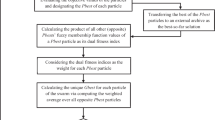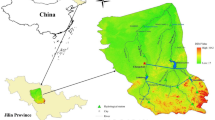Abstract
Heilongjiang reclamation area serves as a crucial hub for commodity grain production and strategic reserves in China, playing a vital role in maintaining national food security. Investigating the assessment of agricultural drought risk in this region can yield valuable insights into spatial and temporal variations in drought risk. Such insights can aid in formulating effective strategies for disaster prevention and mitigation, thereby minimizing food losses caused by drought disasters. This study employs a comprehensive indicator system comprising 17 indicators categorized into hazard, exposure, vulnerability, and resistance capacity. The projection pursuit model is applied to evaluate regional drought risk, while the PSO algorithm, optimized by the SSA algorithm, addresses the limitations of low local search ability and search accuracy during the large-scale search process of the PSO optimization algorithm. This study examines and compares the optimization and convergence capabilities of three algorithms: real number encoding-based genetic algorithm (RAGA), particle swarm optimization algorithm (PSO), and sparrow algorithm-based improved particle swarm optimization algorithm (SSAPSO). The analysis demonstrates that SSAPSO exhibits superior optimization performance and convergence properties, establishing it as a highly effective algorithm for optimization tasks. The findings reveal the following trends: over time, agricultural drought risk in Heilongjiang reclamation area has generally declined, with fluctuations observed in hazard and vulnerability, an increase in exposure, and a continuous enhancement of resistance capacity. Spatially, the western region exhibits significantly higher agricultural drought risk compared to the eastern region, primarily due to elevated hazard and vulnerability, coupled with lower resistance capacity. As the agricultural economy grows and agricultural expertise accumulates, the risk of agricultural drought decreases. However, variations in economic growth among different regions lead to diverse spatial distributions of risk.









Similar content being viewed by others
Data Availability
The datasets used or analyzed during the current study are available from the first author and corresponding author on reasonable request.
References
Arabameri, A., Pal, S. C., Santosh, M., Chakrabortty, R., Roy, P., & Moayedi, H. (2022). Drought risk assessment: Integrating meteorological, hydrological, agricultural and socio-economic factors using ensemble models and geospatial techniques. Geocarto International, 37, 6087–6115. https://doi.org/10.1080/10106049.2021.1926558
Chu, T., Song, Y., & Yang, Z. (2022). sustainability evaluation on crop-farm animal production system of heilongjiang land reclamation area. Journal of China Agricultural Resources and Regional Planning, 43, 8–18.
Dai, M., S. Z. Huang, Q. Huang, G. Y. Leng, Y. Guo, L. Wang, W. Fang, P. Li and X. D. Zheng (2020). Assessing agricultural drought risk and its dynamic evolution characteristics. Agricultural Water Management 231. https://doi.org/10.1016/j.agwat.2020.106003.
Du, G., J. Xie, D. Hou and F. Yu (2023). Regional differences in the green use level of cultivated land in the Heilongjiang reclamation area. Frontiers in Environmental Science 11. https://doi.org/10.3389/fenvs.2023.1134271.
Gan, L., Wang, Y., Wang, Y., Lev, B., Shen, W., & Jiang, W. (2021). Coupling coordination analysis with data-driven technology for disaster-economy-ecology system: An empirical study in China. Natural Hazards, 107, 2123–2153. https://doi.org/10.1007/s11069-021-04787-6
Gao, B., Zheng, Y., Qin, J., Zou, Q., & Wang, Z. (2022). Network intrusion detection algorithm based on sparrow search algorithm and improved particle swarm optimization algorithm. Journal of Computer Applications, 42, 1201–1206.
Ge, M. and H. Lin (2023). Evaluation of China's regional innovation capability based on simulated annealing projection pursuit model and nested fuzzy evaluation model. Expert Systems 40. https://doi.org/10.1111/exsy.13179.
Gong, Y., Zhang, Y., Ding, F., Hao, J., Wang, H., & Zhang, D. (2015). Projection pursuit model for assessment of groundwater quality based on firefly algorithm. Journal of China University of Mining & Technology, 44, 566–572.
Hao, X. (2022). Spatiotemporal variation of carbon source/sink in agricultural ecosystem based on carbon footprint in heilongjiang land reclamation areas. Journal of China Agricultural Resources and Regional Planning, 43, 64–73.
He, J., Y. Li, J. Su and B. Liao (2023). Urban water health: A conceptual framework and assessment system. Frontiers in Ecology and Evolution 10. https://doi.org/10.3389/fevo.2022.1081555.
Hoque, M. A. A., B. Pradhan, N. Ahmed and M. S. I. Sohel (2021). Agricultural drought risk assessment of Northern New South Wales, Australia using geospatial techniques. Science of the Total Environment 756. https://doi.org/10.1016/j.scitotenv.2020.143600.
Jamil, M. and S. Mahmood (2024). Detection and prediction of drought by utilizing integrated geo-spatial and Markov approach in Balochistan, Pakistan. International Journal of Environmental Science and Technology. https://doi.org/10.1007/s13762-024-05474-2.
Jia, Y., Y. Su, R. Zhang, Z. Zhang, Y. Lu, D. Shi, C. Xu and D. Huang (2022). Optimization of an extreme learning machine model with the sparrow search algorithm to estimate spring maize evapotranspiration with film mulching in the semiarid regions of China. Computers and Electronics in Agriculture 201. https://doi.org/10.1016/j.compag.2022.107298.
Jiang, L. (2023). Reflections on the Complementary Advantages of Heilongjiang Reclamation Area and the Pearl River Delta Economic Belt [J] Farm Economic Management. 01:24–26.
Li, R. (2005). Progress and trend analysis of theoretical methodology of water quality assessment. Journal of Hefei University of Technology. Natural Science, 28, 369–373.
Liu, D., Liu, C., Fu, Q., Li, T., Khan, M. I., Cui, S., & Faiz, M. A. (2018). Projection Pursuit Evaluation Model of Regional Surface Water Environment Based on Improved Chicken Swarm Optimization Algorithm. Water Resources Management, 32, 1325–1342. https://doi.org/10.1007/s11269-017-1872-6
Liu, L., Chen, T., Gao, S., Liu, Y., Yang, S., & Wang, X. (2021). Optimization of Agricultural Machinery Allocation in Heilongjiang Reclamation Area Based on Particle Swarm Optimization Algorithm. Tehnicki Vjesnik-Technical Gazette, 28, 1885–1893. https://doi.org/10.17559/tv-20210427163416
Liu, D., G. Zhang, H. Li, Q. Fu, M. Li, M. A. Faiz, S. Ali, T. Li and M. I. Khan (2019). Projection pursuit evaluation model of a regional surface water environment based on an Ameliorative Moth-Flame Optimization algorithm. Ecological Indicators 107. https://doi.org/10.1016/j.ecolind.2019.105674.
Ma, Y., S. Guga, J. Xu, X. Liu, Z. Tong and J. Zhang (2022). Assessment of Maize Drought Risk in Midwestern Jilin Province: A Comparative Analysis of TOPSIS and VIKOR Models. Remote Sensing 14. https://doi.org/10.3390/rs14102399.
Mens, M. J. P., van Rhee, G., Schasfoort, F., & Kielen, N. (2022). Integrated drought risk assessment to support adaptive policymaking in the Netherlands. Natural Hazards and Earth System Sciences, 22, 1763–1776. https://doi.org/10.5194/nhess-22-1763-2022
Murthy, C. S., Laxman, B., & Sai, M. (2015). Geospatial analysis of agricultural drought vulnerability using a composite index based on exposure, sensitivity and adaptive capacity. International Journal of Disaster Risk Reduction, 12, 163–171. https://doi.org/10.1016/j.ijdrr.2015.01.004
Pei, W., Fu, Q., Liu, D., Li, T., Cheng, K., & Cui, S. (2019). A Novel Method for Agricultural Drought Risk Assessment. Water Resources Management, 33, 2033–2047. https://doi.org/10.1007/s11269-019-02225-8
Qi, R., & Pan, J. (2023). Spatial and temporal evolution of ecological vulnerability and its influencing factors in the Hehuang area. Arid Zone Research, 40, 1002–1013.
Ribeiro, A. F. S., Russo, A., Gouveia, C. M., & Pascoa, P. (2019). Modelling drought-related yield losses in Iberia using remote sensing and multiscalar indices. Theoretical and Applied Climatology, 136, 203–220. https://doi.org/10.1007/s00704-018-2478-5
Shao, L., Zhou, X., Yang, F., & Han, J. (2010). Projection pursuit model for comprehensive evaluation of water quality based on free search. China Environmental Science, 30, 1708–1714.
Su, S., Chen, X., DeGloria, S. D., & Wu, J. (2010). Integrative fuzzy set pair model for land ecological security assessment: A case study of Xiaolangdi Reservoir Region, China. Stochastic Environmental Research and Risk Assessment, 24, 639–647. https://doi.org/10.1007/s00477-009-0351-x
Wang, J., Zhang, Y., Huang, C., Zhuang, Y., & Feng, S. (2021). Effects of different mulching on soil water-heat and spring maize yield in newly reclaimed land. Chinese Journal of Eco-Agriculture, 29, 844–854.
Wijitkosum, S. and T. Sriburi (2019). Fuzzy AHP Integrated with GIS Analyses for Drought Risk Assessment: A Case Study from Upper Phetchaburi River Basin, Thailand. Water 11. https://doi.org/10.3390/w11050939.
Xu, D., Liu, D., Liu, D., Fu, Q., Huang, Y., Li, M., & Li, T. (2022). New method for diagnosing resilience of agricultural soil-water resource composite system: Projection pursuit model modified by sparrow search algorithm. Journal of Hydrology 610. https://doi.org/10.1016/j.jhydrol.2022.127814.
Yang, P., X. Zhai, H. Huang, Y. Zhang, Y. Zhu, X. Shi, L. Zhou and C. Fu (2023a). Association and driving factors of meteorological drought and agricultural drought in Ningxia, Northwest China. Atmospheric Research 289. https://doi.org/10.1016/j.atmosres.2023.106753.
Yang, W., L. Zhang and C. Liang (2023b). Agricultural drought disaster risk assessment in Shandong Province, China. Natural Hazards. https://doi.org/10.1007/s11069-023-06057-z.
Ye, Y., Qi, Q., Jiang, L., & Zhang, A. (2018). Impact factors of grain output from farms in Heilongjiang reclamation area based on geographical detector. Geographical Research, 37, 171–182.
Yu, S., & Lu, H. (2018). An integrated model of water resources optimization allocation based on projection pursuit model - Grey wolf optimization method in a transboundary river basin. Journal of Hydrology, 559, 156–165. https://doi.org/10.1016/j.jhydrol.2018.02.033
Yu, J., Ai, P., Yuan, D., & Xiong, C. (2019). Spatial-temporal characteristics of drought in Heilongjiang Province based on standardized precipitation index. Arid Land Geography, 42, 1059–1068.
Yuan, B., S. Wang and L. Guo (2023). Drought Vulnerability Assessment of Winter Wheat Using an Improved Entropy-Comprehensive Fuzzy Evaluation Method: A Case Study of Henan Province in China. Atmosphere 14. https://doi.org/10.3390/atmos14050779.
Zeng, J., & Huang, G. (2018). Set pair analysis for karst waterlogging risk assessment based on AHP and entropy weight. Hydrology Research, 49, 1143–1155. https://doi.org/10.2166/nh.2017.265
Zhang, H. L., Wang, C., & Fan, W. H. (2015). A Projection Pursuit Dynamic Cluster Model Based on a Memetic Algorithm. Tsinghua Science and Technology, 20, 661–671. https://doi.org/10.1109/tst.2015.7350018
Zhang, Y., X. Zou, C. Xu and Q. Yang (2018). Decoupling Greenhouse Gas Emissions from Crop Production: A Case Study in the Heilongjiang Land Reclamation Area, China. Energies 11. https://doi.org/10.3390/en11061480.
Zhang, S. J., P. Wang, D. N. Wang, Y. S. Zhang, R. P. Ji and F. Cai (2022). Identification and Risk Characteristics of Agricultural Drought Disaster Events Based on the Copula Function in Northeast China. Atmosphere 13. https://doi.org/10.3390/atmos13081234.
Zhao, Q., Zou, C. H., Wang, K. F., Gao, Q., & Yao, T. (2019). Spatial and temporal distribution characteristics of drought and its influencing factors in heilongjiang province, China from 1956 TO 2015. Applied Ecology and Environmental Research, 17, 2631–2650. https://doi.org/10.15666/aeer/1702_26312650
Zhou, H., Mao, D., & Li, Y. (2023). A Fault Warning Method for Induced Draft Fans in Thermal Power Plants Based on SSAPSO-LightGBM [J]. Thermal Power Engineering, 38, 153–160. https://doi.org/10.16146/j.cnki.rndlgc.2023.02.021
Zhu, Y., Li, L., Zhao, Y., Liang, Z., Li, H., Wang, L., & Wang, Q. (2018). Regional comprehensive drought disaster risk dynamic evaluation based on projection pursuit clustering. Water Policy, 20, 410–428. https://doi.org/10.2166/wp.2018.010
Zhu, B., Y. Feng, D. Gong, S. Jiang, L. Zhao and N. Cui (2020). Hybrid particle swarm optimization with extreme learning machine for daily reference evapotranspiration prediction from limited climatic data. Computers and Electronics in Agriculture 173. https://doi.org/10.1016/j.compag.2020.105430.
Zhuo, P., Wen, S., Zhang, Q., Luo, J., & Jia, L. (2023). CONSTRUCTION SAFETY RISK ASSESSMENT BASED ON THE PROJECTION PURSUIT MODEL. Journal of Nonlinear and Convex Analysis, 24, 1629–1639.
Funding
This research was supported by funds from the National Natural Science Foundation of China (No. 52009019).
Author information
Authors and Affiliations
Contributions
Shihong Yi (SH Yi): Conceptualization, Methodology, Software, Writing, Data Curation; Wei Pei (W Pei): Project administration, Funding acquisition.
Corresponding author
Ethics declarations
Ethical Approval.
Not applicable.
Consent to Participate
All the authors agree with the participation of this article.
Consent to Publish.
All the authors agree with the publication of this article.
Competing Interests
The authors declare that they have no conflicts of interest related to this work.
Additional information
Publisher's Note
Springer Nature remains neutral with regard to jurisdictional claims in published maps and institutional affiliations.
Rights and permissions
Springer Nature or its licensor (e.g. a society or other partner) holds exclusive rights to this article under a publishing agreement with the author(s) or other rightsholder(s); author self-archiving of the accepted manuscript version of this article is solely governed by the terms of such publishing agreement and applicable law.
About this article
Cite this article
Yi, S., Pei, W. Study on agricultural drought disaster risk assessment in Heilongjiang reclamation area based on SSAPSO optimization projection pursuit model. Environ Monit Assess 196, 477 (2024). https://doi.org/10.1007/s10661-024-12625-y
Received:
Accepted:
Published:
DOI: https://doi.org/10.1007/s10661-024-12625-y




